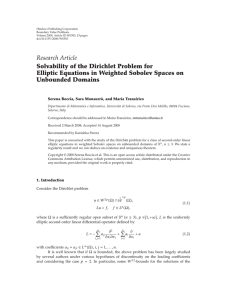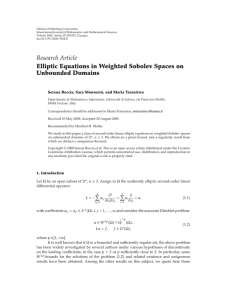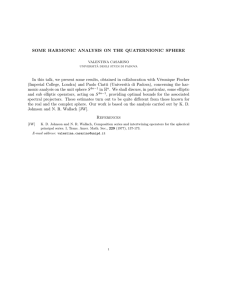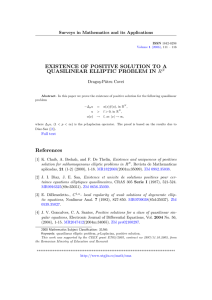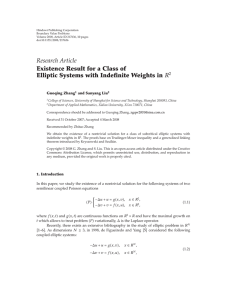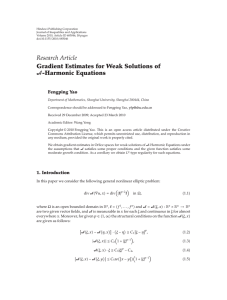BOUNDS FOR ELLIPTIC OPERATORS IN WEIGHTED SPACES
advertisement
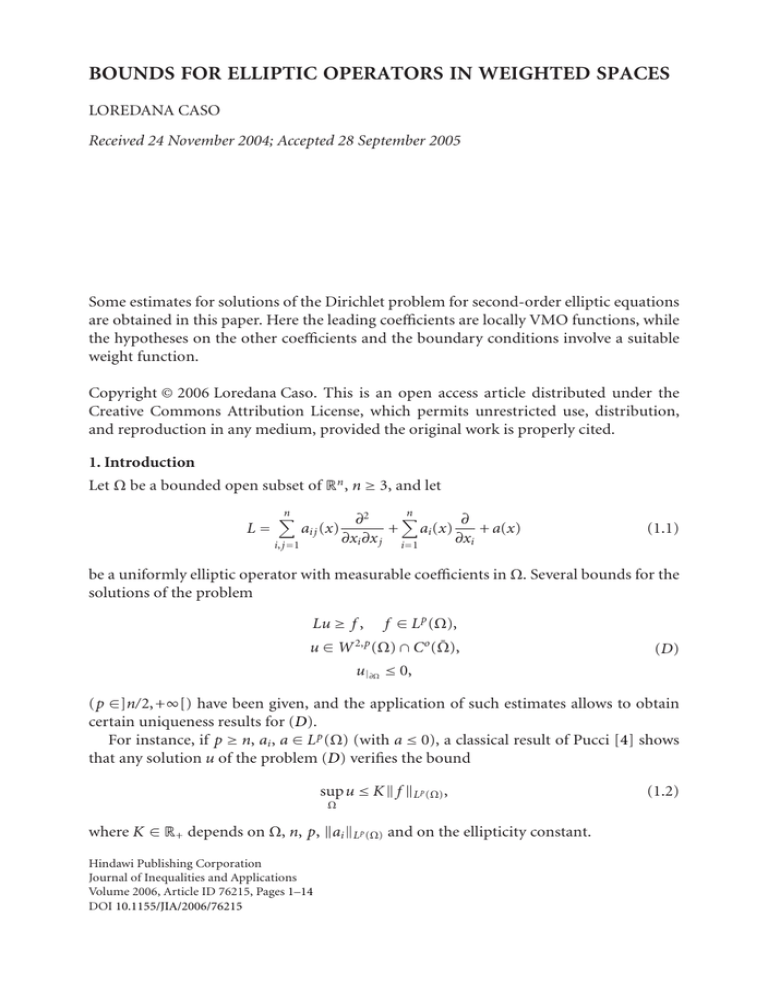
BOUNDS FOR ELLIPTIC OPERATORS IN WEIGHTED SPACES
LOREDANA CASO
Received 24 November 2004; Accepted 28 September 2005
Some estimates for solutions of the Dirichlet problem for second-order elliptic equations
are obtained in this paper. Here the leading coefficients are locally VMO functions, while
the hypotheses on the other coefficients and the boundary conditions involve a suitable
weight function.
Copyright © 2006 Loredana Caso. This is an open access article distributed under the
Creative Commons Attribution License, which permits unrestricted use, distribution,
and reproduction in any medium, provided the original work is properly cited.
1. Introduction
Let Ω be a bounded open subset of Rn , n ≥ 3, and let
L=
n
∂2
∂
+ ai (x)
+ a(x)
∂xi ∂x j i=1
∂xi
n
ai j (x)
i, j =1
(1.1)
be a uniformly elliptic operator with measurable coefficients in Ω. Several bounds for the
solutions of the problem
Lu ≥ f ,
f ∈ L p (Ω),
u ∈ W 2,p (Ω) ∩ C o (Ω̄),
(D)
u|∂Ω ≤ 0,
(p ∈]n/2,+∞[) have been given, and the application of such estimates allows to obtain
certain uniqueness results for (D).
For instance, if p ≥ n, ai , a ∈ L p (Ω) (with a ≤ 0), a classical result of Pucci [4] shows
that any solution u of the problem (D) verifies the bound
sup u ≤ K f L p (Ω) ,
Ω
where K ∈ R+ depends on Ω, n, p, ai L p (Ω) and on the ellipticity constant.
Hindawi Publishing Corporation
Journal of Inequalities and Applications
Volume 2006, Article ID 76215, Pages 1–14
DOI 10.1155/JIA/2006/76215
(1.2)
2
Bounds for elliptic operators in weighted spaces
The case p < n, where additional hypotheses on the leading coefficients are necessary,
has been studied by several authors. Recently, a uniqueness result has been obtained in
[3] under the assumption that the ai j ’s are of class VMO, ai = a = 0 and p ∈]1,+∞[. This
theorem has been extended to the case ai = 0, a = 0 in [7].
If Ω is an arbitrary open subset of Rn and p ∈]n/2,+∞[, a bound of type (1.2) and a
consequent uniqueness result can be found in [1]. In fact, it has been proved there that
if the coefficients ai j are bounded and locally VMO, the coefficients ai , a satisfy suitable
summability conditions and esssupΩ a < 0, then for any solution u of the problem
p
Lu ≥ f ,
f ∈ Lloc (Ω),
2,p
u ∈ Wloc (Ω) ∩ C o (Ω̄),
(D
)
u|∂Ω ≤ 0,
if Ω is unbounded,
limsup u(x) ≤ 0
|x|→+∞
there exist a ball B ⊂⊂ Ω and a constant c ∈ R+ such that
p
sup u ≤ c − f − dx
Ω
1/ p
B
,
(1.3)
where f − is the negative part of f ,
p
1
− f − dx =
| f − | p dx,
|B | B
B
(1.4)
and c depends on n, p, on the ellipticity constant, and on the regularity of the coefficients
of L.
The aim of this paper is to study a problem similar to that considered in [1], but with
boundary conditions depending on an appropriate weight function. More precisely, fix a
weight function σ ∈ Ꮽ(Ω) ∩ C ∞ (Ω) (see Section 2 for the definition of Ꮽ(Ω)) and s ∈ R,
we consider a solution u of the problem
p
Lu ≥ f ,
f ∈ Lloc (Ω),
2,p
u ∈ Wloc (Ω),
limsup σ s (x)u(x) ≤ 0 ∀xo ∈ ∂Ω,
(1.5)
x→xo
s
limsup σ (x)u(x) ≤ 0 if Ω is unbounded.
|x|→+∞
If the coefficients ai j are bounded and locally VMO, the functions σai and σ 2 a are
bounded and esssupΩ σ 2 a < 0, we will prove that there exist a ball B ⊂⊂ Ω and a constant
co ∈ R+ such that
1/ p
s+2 − p
sup σ u ≤ co − σ f
dx
,
s
Ω
B
(1.6)
where co depends on n, p, s, σ, on the ellipticity constant, and on the regularity of the
coefficients of L. As a consequence, some uniqueness results are also obtained.
Loredana Caso 3
2. Notation and function spaces
Let Ω be an open subset of Rn and let Σ(Ω) be the collection of all Lebesgue measurable
subsets of Ω. For each E ∈ Σ(Ω), we denote by |E| the Lebesgue measure of E and put
∀ x ∈ Rn , ∀ r ∈ R+ ,
E(x,r) = E ∩ B(x,r)
(2.1)
where B(x,r) is the open ball in Rn of radius r centered at x.
Denote by Ꮽ(Ω) the class of measurable functions ρ : Ω → R+ such that
β−1 ρ(y) ≤ ρ(x) ≤ βρ(y) ∀ y ∈ Ω, ∀x ∈ Ω y,ρ(y) ,
(2.2)
where β ∈ R+ is independent of x and y. For ρ ∈ Ꮽ(Ω), we put
Sρ = z ∈ ∂Ω : lim ρ(x) = 0 .
(2.3)
x→z
It is known that
ρ ∈ L∞
loc (Ω̄),
ρ −1 ∈ L ∞
loc Ω̄ \ Sρ ,
(2.4)
and, if Sρ = ∅,
ρ(x) ≤ dist x,Sρ
∀x ∈ Ω
(2.5)
(see [2, 6]). Having fixed ρ ∈ Ꮽ(Ω) such that Sρ = ∂Ω, it is possible to find a function
σ ∈ Ꮽ(Ω) ∩ C ∞ (Ω) ∩ C 0,1 (Ω̄) which is equivalent to ρ and such that
σ ∈ L∞
loc (Ω̄),
σ −1 ∈ L ∞
loc (Ω),
σ(x) ≤ dist(x,∂Ω) ∀x ∈ Ω,
α
∂ σ(x) ≤ cα σ 1−|α| (x) ∀x ∈ Ω, ∀α ∈ Nn ,
o
γ−1 σ(y) ≤ σ(x) ≤ γσ(y) ∀ y ∈ Ω, ∀x ∈ Ω y,σ(y) ,
(2.6)
(2.7)
(2.8)
(2.9)
where cα ,γ ∈ R+ are independent of x and y (see [6]). For more properties of functions
of Ꮽ(Ω) we refer to [2, 6].
If Ω has the property
Ω(x,r) ≥ Ar n
∀x ∈ Ω, ∀r ∈]0,1],
(2.10)
where A is a positive constant independent of x and r, it is possible to consider the space
BMO(Ω,t), t ∈ R+ , of functions g ∈ L1loc (Ω̄) such that
[g]BMO(Ω,t) = sup −
x∈Ω
r ∈]0,t]
Ω(x,r)
g − −
Ω(x,r)
g
d y < +∞,
where −Ω(x,r) gd y = 1/ |Ω(x,r)| Ω(x,r) gd y. If g ∈ BMO(Ω) = BMO(Ω,tA ), where
⎧
⎫
⎪
⎪
⎨
n
r
1⎬
≤
tA = sup ⎪t ∈ R+ : sup ,
Ω(x,r)
A⎪
⎩
⎭
x∈Ω
r ∈]0,t]
(2.11)
(2.12)
4
Bounds for elliptic operators in weighted spaces
we will say that g ∈ VMO(Ω) if [g]BMO(Ω,t) → 0 for t → 0+ . A function η[g] : R+ → R+ is
called a modulus of continuity of g in VMO(Ω) if
≤ η[g](t)
BMO(Ω,t)
∀ t ∈ R+ ,
(2.13)
lim η[g](t) = 0.
t →0+
We say that g ∈ VMOloc (Ω) if (ζg)o ∈ VMO(Rn ) for any ζ ∈ Co∞ (Ω), where (ζg)o denotes
the zero extension of ζg outside of Ω. A more detailed account of properties of the above
defined spaces BMO(Ω) and VMO(Ω) can be found in [5].
3. An a priori bound
Fix p ∈]n/2,+∞[. Let B be an open ball of Rn , n ≥ 3, of radius δ. We consider in B the
differential operator
LB =
n
∂2
∂
+ αi (x)
+ α(x),
∂xi ∂x j i=1
∂xi
n
αi j (x)
i, j =1
(3.1)
with the following condition on the coefficients:
αi j = α ji ∈ L∞ (B) ∩ VMO(B),
n
∃ μ ∈ R+ :
αi j ζi ζ j ≥ μ|ζ |2
i, j = 1,...,n,
a.e. in B, ∀ζ ∈ Rn ,
i, j =1
αi ∈ L∞ (B),
(hB )
i = 1,...,n, α ∈ L∞ (B), α ≤ 0 a.e. in B.
Let μ0 ,μ1 ,μ2 ∈ R+ such that
n
αi j i, j =1
L∞ (B) ≤ μ0 ,
δ
n
αi 1=1
L∞ (B)
≤ μ1 ,
δ 2 αL∞ (B) ≤ μ2 .
(3.2)
Note that under the assumption (hB ), the operator LB from W 2,p (B) into L p (B) is
bounded and the estimate
L B u L p (B)
∀u ∈ W 2,p (B)
≤ c1 uW 2,p (B)
(3.3)
holds, where c1 ∈ R+ depends on n, p, μ0 , μ1 , μ2 .
Lemma 3.1. Suppose that condition (hB ) is verified, and let u be a solution of the problem
u ∈ W 2,p (B),
LB u ≥ φ,
φ ∈ L p (B),
(3.4)
u|∂B ≤ 0.
Then there exists c ∈ R+ such that
sup u ≤ cδ 2−n/ p φ− L p (B) ,
B
(3.5)
Loredana Caso 5
where c depends on n, p, μ, μ0 , μ1 , μ2 , [p(αi j )]BMO(Rn ,·) , and where p(αi j ) is an extension
of αi j to Rn in L∞ (Rn ) ∩ VMO(Rn ).
Proof. Put B = B(y,δ), where y is the centre of B, and B∗ = B(y,1).
Consider the function T : B → B∗ defined by the position
T(x) = y +
x−y
= z,
δ
(3.6)
and for each function g defined on B, put g ∗ = g ◦ T −1 .
We observe that
∗
L∗B u∗ = δ 2 LB u ,
(3.7)
∂2
∂
+ δ α∗i (z)
+ δ 2 α∗ (z).
∂zi ∂z j
∂z
i
i=1
(3.8)
where
L∗B =
n
α∗i j (z)
i, j =1
n
Denote by p(αi j ) an extension of αi j to Rn such that
p αi j ∈ L∞ Rn ∩ VMO Rn
(3.9)
(for the existence of such function see [5, Theorem 5.1]). Since
p αi j
∗
∈ L∞ Rn ∩ VMO Rn ,
p αi j
∗
|B∗
= α∗
ij,
(3.10)
it follows that
α∗i j ∈ L∞ (B∗ ) ∩ VMO(B∗ ).
(3.11)
Moreover, the condition (hB ) yields that
α∗i j = α∗ji ,
n
α∗i j ζi ζ j ≥ μ|ζ |2
i, j = 1,...,n,
a.e. in B∗ , ∀ζ ∈ Rn ,
(3.12)
i, j =1
α∗i ∈ L∞ (B∗ ),
i = 1,...,n,
α∗ ∈ L∞ (B∗ ),
α∗ ≤ 0
a.e. in B ∗ .
We observe that the condition (3.12) implies that for r, s ∈]1,+∞[ the modulus of continuity of δα∗i in Lr (B∗ ) and that of δ 2 α∗ in Ls (B∗ ) depend only on δα∗i L∞ (B∗ ) and
δ 2 α∗ L∞ (B∗ ) , respectively.
Thus, applying (3.10), (3.12), and [7, Theorem 2.1], it follows that the problem
L∗B v = ψ ∈ L p (B∗ ),
o
v ∈ W2,p (B∗ ) ∩ W 1,p (B∗ )
(3.13)
6
Bounds for elliptic operators in weighted spaces
has a unique solution v satisfying the estimate
v W 2,p (B∗ ) ≤ K ψ L p (B∗ ) ,
(3.14)
where K depends on n, p, μ, μ0 , μ1 , μ2 , [p(αi j )∗ ]BMO(Rn ,·) .
The estimate (3.5) follows now from (3.14) using the same arguments of the proof of
Lemma 3.2 [1] in order to obtain there (eB ) from [1, (3.23)].
4. Hypotheses and preliminary results
Let Ω be an open subset of Rn , n ≥ 3. Fix ρ ∈ Ꮽ(Ω) ∩ L∞ (Ω) such that Sρ = ∂Ω.
Consider a function g ∈ Co∞ (R̄+ ) satisfying the condition
1
g(t) = 0 if t ≤ .
2
g(t) = 1 if t ≥ 1,
0 ≤ g ≤ 1,
(4.1)
For any k ∈ N, we put
1
ηk (x) = ζk (x) + 1 − ζk (x) σ(x),
k
x ∈ Ω,
(4.2)
where ζk (x) = g(kσ(x)), x ∈ Ω. Clearly, ηk ∈ C ∞ (Ω) for any k ∈ N and
⎧
⎪
⎨1
if x ∈ Ω̄k ,
ηk (x) = ⎪ k
⎩σ(x) if x ∈ Ω \ Ω2k ,
(4.3)
where
Ωk = x ∈ Ω : σ(x) >
1
,
k
k ∈ N.
(4.4)
In the following we will use the notation
fx =
n
i=1
1/2
fx2i
fxx =
,
1/2
n
i, j =1
fx2i x j
.
(4.5)
It is easy to show that for each k ∈ N,
σ(x) ≤ ηk (x) ≤ 2σ(x),
ck σ(x) ≤ ηk (x) ≤ σ(x),
ηk (x)
ηk (x)
xx
≤ c2
x
≤ c1 σ(x) x ,
2
x ∈ Ω \ Ω̄k ,
(4.6)
x ∈ Ωk ,
(4.7)
x ∈ Ω,
(4.8)
σ(x) x + σ(x) σ(x)
σ(x)
xx
,
x ∈ Ω,
(4.9)
Loredana Caso 7
where ck
∈ R+ depends on k and σ, and c1 ,c2 ∈ R+ depend only on n. Moreover, for any
s ∈ R, we have
ηks (x) x
ηk (x) x
≤ c3
,
ηks (x)
σ(x)
2
x ∈ Ω,
ηks (x) xx
ηk (x) x + ηk (x) ηk (x)
≤ c3
ηks (x)
σ 2 (x)
(4.10)
xx
,
x ∈ Ω,
(4.11)
where c3 ∈ R+ depends on s and n.
We consider in Ω the differential operator
n
L=
∂2
∂
+ ai (x)
+ a(x),
∂xi ∂x j i=1
∂xi
n
ai j (x)
i, j =1
(4.12)
and put
n
Lo =
ai j (x)
i, j =1
∂2
.
∂xi ∂x j
(4.13)
We will make the following assumption on the coefficients of L:
ai j = a ji ∈ L∞ (Ω) ∩ VMOloc (Ω),
∃ν,ν0 ∈ R+ :
n
ai j i, j =1
L∞ (Ω)
n
≤ ν0 ,
ai j ζi ζ j ≥ ν|ζ |2
a.e. in Ω, ∀ζ ∈ Rn ,
i, j =1
n
∃ν1 ,ν2 ∈ R+ : esssup σ(x)
ai (x) ≤ ν1 ,
Ω
i, j = 1,...,n,
i=1
2
(h1 )
esssup σ 2 (x)|a(x)| ≤ ν2 ,
Ω
∃ao ∈ R+ : esssup σ (x)a(x) = −ao .
Ω
Fixed s ∈ R, let u be a solution of the problem
Lu ≥ f ,
p
f ∈ Lloc (Ω),
2,p
u ∈ Wloc (Ω),
limsup σ s (x)u(x) ≤ 0 ∀xo ∈ ∂Ω,
x→xo
s
(P)
limsup σ (x)u(x) ≤ 0 if Ω is unbounded.
|x|→+∞
For any k ∈ N, we put
wk (x) = ηks (x)u(x),
x ∈ Ω.
(4.14)
8
Bounds for elliptic operators in weighted spaces
Lemma 4.1. Suppose that condition (h1 ) holds. Then, for any k ∈ N there exist functions
bik (i = 1,...,n), bk , g k and positive constants β1 and β2 such that
esssup σ(x)
Ω
n
k b (x) ≤ β1 ,
(4.15)
i
i=1
esssup σ 2 (x)bk (x) ≤ β2 ,
(4.16)
Ω
p
g k ∈ Lloc (Ω),
(4.17)
where β1 depends on s, n, ν0 , ν1 and β2 depends on s, n, ν0 , ν2 . Moreover, the function
wk , k ∈ N, satisfies the following conditions:
2,p
wk ∈ Wloc (Ω),
limsup wk (x) ≤ 0
∀xo ∈ ∂Ω,
x→xo
(4.18)
limsup wk (x) ≤ 0 if Ω is unbounded,
|x|→+∞
n
Lo wk +
bik wk
i =1
in Ω.
+ bk wk ≥ g k
xi
(4.19)
Proof. Fix k ∈ N. From (4.6)–(4.11) and from (2.6), (2.8), it easily follows that the function wk , defined by (4.14), verifies (4.18).
Moreover, observe that
Lo wk − uLo ηks − 2
−u
n
i, j =1
n
i=1
ai ηks xi
ηks x j uxi
=
x j ux i +
n
i=1
+ aηks u = ηks Lu,
Since
ai j ηks
ηks u xi
ηks
xj
ηks
−
ηks
ai ηks u
xi
(4.20)
x ∈ Ω.
s
xi (ηk )x j
s 2
ηk
ηks u ,
(4.21)
from (4.20), (4.19) follows, where we have put
bik
= ai − 2
n
ai j
j =1
bk = a + 2
n
i, j =1
g
k
= ηks
n
ηks
ai j
xj
ηks
ηks
i = 1,...,n,
,
xi
ηks
2
ηks
xj
−
n
i, j =1
ai j
ηks
xi x j
ηks
,
(4.22)
ηks x
f + ai s i wk .
ηk
i =1
On the other hand, using the hypothesis (h1 ), (4.6)–(4.11), and (2.8) it is easy to show
that there exist β1 ∈ R+ depending on s, n, ν0 , ν1 and β2 ∈ R+ depending on s, n, ν0 , ν2 ,
such that (4.15), (4.16), (4.17) hold.
Loredana Caso 9
Now we suppose that the following hypothesis on ρ holds:
lim
k→+∞
sup
Ω\Ωk
σ(x) x + σ(x) σ(x)
xx
= 0.
(h2 )
An example of function ρ such that σ satisfies (h2 ) is provided in [2].
Lemma 4.2. Suppose that conditions (h1 ) and (h2 ) hold. Then there exists ko ∈ N such that
n
ko a
esssup σ(x)
bi (x) ≤ ν1 + o ,
2
a
esssup σ 2 (x)bko (x) ≤ − o ,
2
Ω
a
g ko (x) ≥ ηks o (x) f (x) − o σ −2 (x)wko (x), x ∈ Ω.
8
Ω
i=1
(4.23)
Proof. From (4.10), (4.11), and hypothesis (h1 ), we deduce that
s ηk x j n
σ
a
ij
s ≤ c4 ηk x ,
ηk i, j =1
s ηks xi ηks x j η k xi x j n
n
2
2
≤ c5 ηk 2 + ηk ηk
ai j
+
σ
a
σ s 2
i
j
s
x
xx ,
ηk i, j =1
i, j =1
ηk
s n
η k xi σ2 ai ηs ≤ c6 ηk x ,
i=1
k (4.24)
where c4 ,c5 ∈ R+ depend on s, n, ν0 and c6 ∈ R+ depends on s, n, ν1 . Observing that
(ηk )x = (ηk )xx = 0 in Ω̄k , the statement follows now from (4.8), (4.9), (h1 ), (h2 ), and
(4.24).
5. Main results
It is well know that there exists a function α̃ ∈ C ∞ (Ω) ∩ C 0,1 (Ω̄) which is equivalent to
dist(·,∂Ω) (see, e.g., [8]). For every positive integer m, we define the function
ψm : x ∈ Ω̄ −→ g mα̃(x)
1−g
|x|
2m
,
(5.1)
where g ∈ C ∞ (R̄+ ) verifies (4.1). It is easy to show that ψm belongs to Co∞ (Ω) for every
m ∈ N and
0 ≤ ψm ≤ 1,
suppψm ⊆ E2m ,
ψm |Ēm = 1,
(5.2)
where
Em = x ∈ Ω : |x| < m, α̃(x) >
1
.
m
(5.3)
10
Bounds for elliptic operators in weighted spaces
Remark 5.1. It follows from hypothesis (h1 ) and from [5, Lemma 4.2] that for any m ∈ N
the functions (ψm ai j )o (obtained as extensions of ψm ai j to Rn with zero values out of Ω)
belong to VMO(Rn ) and
ψm ai j
o BMO(Rn ,t)
≤ ψm ai j BMO(Ω,t) ,
(5.4)
for t small enough.
In the following we denote by w, bi , b, and g the functions defined by (4.14), (4.22),
respectively, corresponding to k = ko , where ko is the positive integer of Lemma 4.2
We can now prove the main result of the paper.
Theorem 5.2. Suppose that conditions (h1 ) and (h2 ) hold, and let u be a solution of the
problem (P). Then there exist an open ball B ⊂⊂ Ω and a constant co ∈ R+ such that
p
sup σ s (x)u(x) ≤ co − σ s+2 f − dx
Ω
1/ p
B
,
(5.5)
where co depends only on n, p, s, γ, ν, ν0 , ν1 , ν2 , ao , η[ψm ai j ] (m ∈ N).
Proof. It can be assumed that supΩ σ s (x) u(x) > 0. Thus it follows from (4.14) and (4.18)
that there exists y ∈ Ω such that supΩ w(x) = w(y); moreover, there exists Ro ∈]0,
dist(y,∂Ω)[ such that w(x) > 0 for all x ∈ B(y,Ro ).
Let λ,α,αo ∈ R+ , with αo > 1 (that will be chosen late), such that
α = αo σ(y).
λα ≤ min{Ro ,σ(y)},
(5.6)
In the following we denote by B the open ball B(y,αλ).
We put
ϕ(x) = 1 + λ2 −
|x − y |2
α2
x ∈ B̄,
,
(5.7)
and observe that
1 ≤ ϕ(x) ≤ 1 + λ2 ≤ 2,
ϕxi ≤
2λ
,
α
ϕxi ϕx j ≤
ϕxi x j = 0 if i = j,
4λ2
α2
,
x ∈ B̄,
(5.8)
i, j = 1,...,n,
(5.9)
ϕxi x j = −
2
α2
if i = j.
(5.10)
Consider now the function v defined by
v(x) = ϕ(x)w(x) − w(y),
x ∈ B̄.
(5.11)
v(y) = λ2 w(y).
(5.12)
Obviously,
v|∂Ω = w|∂Ω − w(y) ≤ 0,
Loredana Caso 11
It is easy to show that
Lo (ϕw) − wLo ϕ − 2
n
ai j ϕx j wxi +
i, j =1
−
n
n
bi (ϕw)xi
i =1
bi ϕxi w + bϕw = ϕ Lo w +
i =1
n
(5.13)
bi wxi + bw ≥ ϕg
in B.
i=1
Thus
Lo (ϕw) +
n
di (ϕw)xi + dϕw ≥ ϕg +
i=1
n
bi ϕxi w
in B,
(5.14)
i =1
where
di = bi − 2
n
ai j
ϕx j
,
ϕ
ai j
n
ϕxi ϕx j ϕxi x j
−
ai j
.
ϕ2
ϕ
i, j =1
(5.16)
di vxi + dv ≥ h,
(5.17)
j =1
d = b+2
n
i, j =1
i = 1,...,n,
(5.15)
Therefore we obtain from (5.14) that
Lo v +
n
i=1
where
h = ϕg + w
n
bi ϕxi − dw(y).
(5.18)
i=1
Clearly, (2.9), (5.6), and (5.9) yield that
ϕx ≤ 2γ
i
σ
α2o σ 2 (y)
in B,
(5.19)
and hence it follows from Lemma 4.2 that
a 1
a o −2
σ ϕw(y) − 2γw(y) ν1 + o 2 σ −2 (y) − dw(y)
8
2 αo
γν
γa
a
1
o
o 2
≥ ϕηks o f + − d −
γ + 2 2 + 2 σ −2 (y) w(y).
4
αo
αo
h ≥ ϕηks o f −
(5.20)
The constant αo can be chosen in such a way that d < −do σ −2 (y) in B, where
do =
γν1 γao
ao 2
γ +2 2 + 2 .
4
αo
αo
(5.21)
12
Bounds for elliptic operators in weighted spaces
In fact, by Lemma 4.2, (5.9) and (5.10), we have
d + do σ −2 (y) = b + 2
n
ai j
i, j =1
n
ϕxi ϕx j ϕxi x j
−
ai j
+ do σ −2 (y)
2
ϕ
ϕ
i, j =1
λ2
ao
1
≤ − σ −2 + 8νo 2 + 2νo 2 + do σ −2 (y)
2
α
α
1
2 ao
≤ −γ
+ 10νo + 2γν1 + γao 2 σ −2 (y),
(5.22)
αo
4
and hence, fixed αo such that
γ 2 ao
1
,
≤ 2
αo 4 10νo + 2γν1 + γao
(5.23)
d < −do σ −2 (y) in B.
(5.24)
it follows that
By (5.11), (5.12), and (5.15)–(5.17), we deduce that the problem
v ∈ W 2,p (B),
Lo v +
n
i =1
di vxi + dv ≥ ϕηks o f ,
f ∈ L p (B),
(5.25)
v|∂B ≤ 0
satisfies the hypotheses of Lemma 3.1. Therefore, it follows from (5.6), (4.15), and (4.16)
that there exists a constant c1 ∈ R+ , depending on n, p, s, γ, ν, ν0 , ν1 , ν2 , [p(ai j |B )]BMO(Rn ,·) ,
such that
v(x) ≤ c1 (λα)2−n/ p ϕηks o f
− ∀x ∈ B.
L p (B)
(5.26)
So it follows from (5.8) and from (5.26) with x = y that
λ2 w(y) ≤ c1 (λα)2−n/ p ϕηks o f
− ≤ 2c1 (λα)2−n/ p ηks o f − .
(5.27)
w(y) ≤ c2 (λα)−n/ p α2o σ 2 (y)ηks o f − L p (B) ≤ c3 (λα)−n/ p α2o σ 2 ηks o f − L p (B) ,
(5.28)
L p (B)
L p (B)
Thus by (5.6) and (5.27) we have
where c2 ,c3 ∈ R+ depend on the same parameters as c1 . Finally from (4.6), (4.7), (4.14),
and (5.28) we obtain
sup σ s u ≤ c4 (λα)−n/ p
Ω
B
2+s − p
σ f dx
1/ p
1/ p
≤ c5 − σ s+2 f − dx
,
B
(5.29)
Loredana Caso 13
where c4 ,c5 ∈ R+ depend on the same parameters as c1 and on ao . Then, if we choose
p ai j |B = ψm1 ai j o ,
(5.30)
where m1 is a positive integer such that ψm1 |B = 1, (5.5) follows from (5.29), (5.30), and
from Remark 5.1.
Corollary 5.3. Suppose that conditions (h1 ) and (h2 ) hold, and let u be a solution of the
problem
2,p
σ s+2 f ∈ L∞ (Ω),
Lu = f ,
u ∈ Wloc (Ω),
limsup σ s (x)u(x) = 0 ∀xo ∈ ∂Ω,
(p
)
x→xo
s
limsup σ (x)u(x) = 0 if Ω is unbounded.
|x|→+∞
Then
sup σ s |u| ≤ co σ s+2 f L∞ (Ω) ,
Ω
(5.31)
where co ∈ R+ is the constant of the statement of Theorem 5.2.
Proof. The result can be obtained applying Theorem 5.2 to the functions u and −u.
The following uniqueness result is an obvious consequence of Corollary 5.3.
Corollary 5.4. If the hypotheses (h1 ) and (h2 ) hold, then the problem
Lu = 0,
2,p
u ∈ Wloc (Ω),
limsup σ s (x)u(x) = 0 ∀xo ∈ ∂Ω,
x→xo
s
(p
)
limsup σ (x)u(x) = 0 if Ω is unbounded
|x|→+∞
has only the zero solution.
References
[1] L. Caso, P. Cavaliere, and M. Transirico, On the maximum principle for elliptic operators, Mathematical Inequalities & Applications 7 (2004), no. 3, 405–418.
[2] L. Caso and M. Transirico, Some remarks on a class of weight functions, Commentationes Mathematicae Universitatis Carolinae 37 (1996), no. 3, 469–477.
[3] F. Chiarenza, F. Frasca, and P. Longo, W 2,p -solvability of the Dirichlet problem for nondivergence
elliptic equations with VMO coefficients, Transactions of the American Mathematical Society 336
(1993), no. 2, 841–853.
[4] C. Pucci, Limitazioni per soluzioni di equazioni ellittiche, Annali di Matematica Pura ed Applicata
74 (1996), 15–30.
[5] M. Transirico, M. Troisi, and A. Vitolo, BMO spaces on domains of Rn , Ricerche di Matematica
45 (1996), no. 2, 355–378.
[6] M. Troisi, Su una classe di funzoni peso, Rendiconti. Accademia Nazionale delle Scienze detta dei
XL. Serie V. Memorie di Matematica 10 (1986), no. 1, 141–152.
14
Bounds for elliptic operators in weighted spaces
[7] C. Vitanza, A new contribution to the W 2,p regularity for a class of elliptic second order equations
with discontinuous coefficients, Le Matematiche 48 (1993), no. 2, 287–296.
[8] W. P. Ziemer, Weakly Differentiable Functions, Graduate Texts in Mathematics, vol. 120, Springer,
New York, 1989.
Loredana Caso: Dipartimento di Matematica e Informatica, Facoltà di Scienze MM.FF.NN.,
Università di Salerno, Via Ponte don Melillo, 84084 Fisciano (SA), Italy
E-mail address: lorcaso@unisa.it
